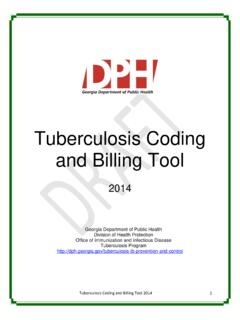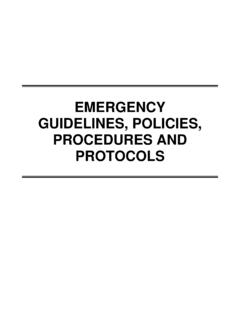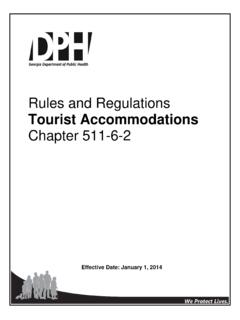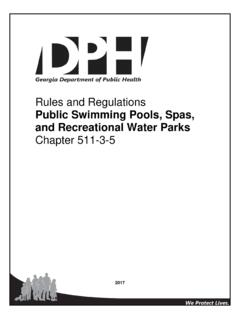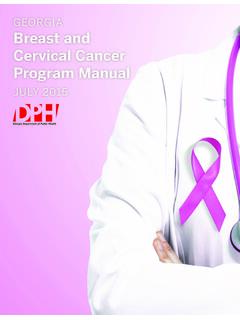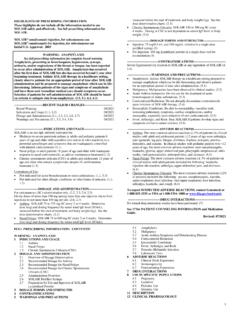Transcription of Hypertension Action Guide for Health Care Providers
1 1 Hypertension Management Action Guide for Health Care Providers 2 For more information, please contact: Gayathri Suresh Kumar, MD Medical Officer chronic Disease, Healthy Behaviors, and Injury Epidemiology Section Georgia Department of Public Health 2 Peachtree Street, 14th Floor Atlanta, GA 30303-3142 Phone: 404-657-2577 Contributors: Gayathri Suresh Kumar, MD Medical Officer Division of Epidemiology Georgia Department of Public Health J. Patrick O Neal, MD Director of Health Protection Georgia Department of Public Health Victoria Davis, MPH chronic Disease Epidemiologist Division of Epidemiology Georgia Department of Public Health 3 Table of Contents 1. I. Background ..4 a. Why is Hypertension important? ..4 b. What is Hypertension ?
2 4 c. What are common risk factors for Hypertension ? ..4 d. What are the symptoms of Hypertension ? ..5 2. II. Overview: Steps of Patient Visit..6 3. III. Step 1: Build a relationship with the patient..7 4. IV. Step 2: Evaluate the patient..8 a. Step : Manually check the blood pressure..8 b. Step : Take a careful history..9 c. Step : Conduct a physical examination..10 d. Step : Laboratory tests and other diagnostic procedures..11 5. V. Step 3: Talk about the blood pressure..12 a. Step : Discuss meaning of blood pressure readings..12 b. Step : Flowchart of Hypertension management..13 6. VI. Step 4: Talk about the medications. (Skip to Step 5 if just initiating treatment)..14 a. Step : Assess patient adherence to blood pressure medications..14 b. Step : Discuss strategies through which to improve medication adherence..16 7. VII. Step 5: Develop and discuss treatment plan.
3 17 a. Step : Determine the blood pressure ..18 b. Step : Discuss lifestyle modifications..19 c. Step : Initiate or intensify blood pressure treatment..20 i. Step Treatment for Adults < 60 years..20 ii. Step Treatment for Adults 60 years..25 d. Step : Discuss treatment plan..25 8. VIII. Step 6: Provide patient with appropriate self-management tools..26 9. IX. Step 7: Follow-up with the patient..28 a. Step : Determine when the next clinic appointment shall be..28 b. Step : During the period between visits..28 c. Step : At the scheduled follow-up visit..28 10. X. Step 8: Refer or consult with appropriate specialists when necessary..30 11. XI. Appendix A: Evaluation of secondary causes of Hypertension ..32 12. XII. References..33 4 I. Background1-2 Why is Hypertension Important? Hypertension , or abnormally high blood pressure, is a leading risk factor for cardiovascular disease.
4 In the United States, there are approximately 67 million adults who have Hypertension , of whom over half do not have it under control. Among the adults whose Hypertension was not under control, 14 million were unaware they had Hypertension . In Georgia, over 2 million adults, or 35% of Georgia s population, have Hypertension . Managing high blood pressure is important because if left uncontrolled, it can lead to other Health conditions and even death. Health consequences of high blood pressure may include: Coronary artery disease Heart attack Heart disease Congestive heart failure Stroke Kidney damage Vision loss Erectile dysfunction in males What is Hypertension ? Blood pressure is the force being applied against arterial walls as the heart pumps blood throughout the body. Systolic pressure (top number) represents the force that occurs when the heart is pushing the blood out of the heart into the arteries.
5 Diastolic pressure (bottom number) represents the pressure in the arteries when the heart is filling up with blood ( , the peripheral arterial tone). Essential or primary Hypertension is defined as having a blood pressure reading of 140/90 mm Hg without a known cause (idiopathic) Hypertension is diagnosed when on at least two doctor visits, the average of two or more readings of systolic and diastolic measurements are 140 mm Hg or 90 mmHg, respectively. Essential Hypertension accounts for 95% of all Hypertension diagnoses in the United States. What are common risk factors for Hypertension ? The common risk factors for Hypertension include the following: Family history of high blood pressure Poor diet and having too much salt in your diet History of smoking and second-hand smoke exposure Drinking too much alcohol 5 Lack of physical activity Having diabetes Being overweight or obese African American race What are the symptoms of Hypertension ?
6 People who have Hypertension normally will not experience symptoms. However, people experiencing a hypertensive crisis may exhibit symptoms such as: Severe headache Nosebleeds Changes in vision Nausea or vomiting Shortness of breath Confusion Chest pain 6 II. Overview: Steps of Patient Visit. Figure 1 Build a relationship with the patient Evaluate the patient Talk about their blood pressure Talk about the medications Develop and discuss treatment plan Provide patient with appropriate self-management tools Follow-up with the patient Refer or consult when necessary Step 1 Step 2 Step 3 Step 4 Step 5 Step 6 Step 7 Step 8 7 III. Step 1: Build a relationship with the patient. Get to know your patients so you can 1) foster comfort and trust between yourself and the patient and 2) better understand their level of knowledge about high blood pressure and blood pressure management goals.
7 Reinforce that you are interested, qualified and available to help them reach their blood pressure goals. Depending upon whether this is a first visit or a follow-up visit, ask appropriate and simple questions to help you determine patients goals and concerns and if patients understand their condition, risks, and the importance of medication adherence. The questions can be tailored to whether this is the first visit or a subsequent visit with the patient and what has already been addressed in previous visits. As examples: What is most important for you to accomplish during your visit today? What have you been doing since our last visit to control your blood pressure? What concerns you the most about your high blood pressure? Do you have any questions about watching your blood pressure at home? Do you have any questions about your prescriptions? What specifically would you like to work on to manage your high blood pressure?
8 How confident are you that you could do [behavior] to help control your blood pressure? What might get in the way or keep you from being successful? What do you think would make it easier to control your high blood pressure? 8 IV. Step 2: Evaluate the patient3 A diagnosis of Hypertension is based on the average of two or more properly measured, seated blood pressure readings on each of two or more office visits. Step Check the blood pressure. Blood pressure can be measured via the following methods: 1) manually, 2) with an automated machine, 3) ambulatory blood pressure monitoring, and 4) home blood pressure monitoring. Ambulatory blood pressure monitoring is indicated in any of the following conditions: Suspected white-coat Hypertension Apparent drug resistance Hypotensive symptoms with antihypertensive medication Episodic Hypertension Autonomic dysfunction Manual blood pressure measurement a.
9 Check the condition of the device and the cuff size to ensure the reading is accurate. b. Make sure patient is relaxed and has been seated comfortably for 5 minutes in a chair (not exam table) with feet on the floor and arm supported at heart level. c. Have the patient relax and sit with their arm slightly bent on the same level as their heart and resting comfortably on a table or other flat surface. d. Place the inflatable blood pressure cuff securely on the upper arm (approximately one inch above the bend of the elbow). e. Close the pressure valve on the rubber inflating bulb, and pump the bulb rapidly to inflate the cuff. f. If using a stethoscope, place the earpieces in your ears and the bell of the stethoscope over the artery, just below the cuff. g. Now slowly release the pressure by twisting or pressing open the pressure valve, located on the bulb. Listen through the stethoscope and note on the dial when you first start to hear a pulsing or tapping sound this is the systolic blood pressure.
10 H. Continue letting the air out slowly. Note on the dial when the sounds completely stop this is the diastolic blood pressure. 9 Step Take a careful history. From a careful history, it is important to determine and discuss 1) past medical problems including history of Hypertension and other chronic illnesses, 2) family history, 3) any modifiable risk factors that can worsen pre- Hypertension (defined in Step ) and/or Hypertension , and 4) symptoms suggestive of end-organ damage and causes of secondary Hypertension . Table 1: Pertinent History Past Medical History History of high blood pressure-duration and levels Results and side effects of previous blood pressure treatment Medication use (herbals, over-the-counter, oral contraceptives, steroids, NSAIDS, nasal decongestants, appetite suppressants, tricyclic anti-depressants, MAO inhibitors, cocaine, other drugs) History of diabetes, heart disease, kidney disease, dyslipidemia, & tobacco use Family History Hypertension Premature cardiovascular disease Cerebrovascular disease Diabetes Dyslipidemia Diet and Activity History Dietary intake ( , patient s intake for each meal in the last 24 hours)
